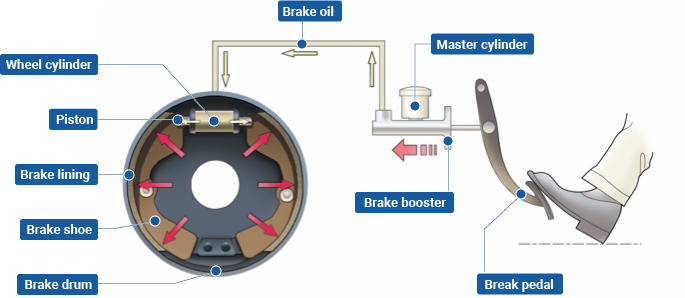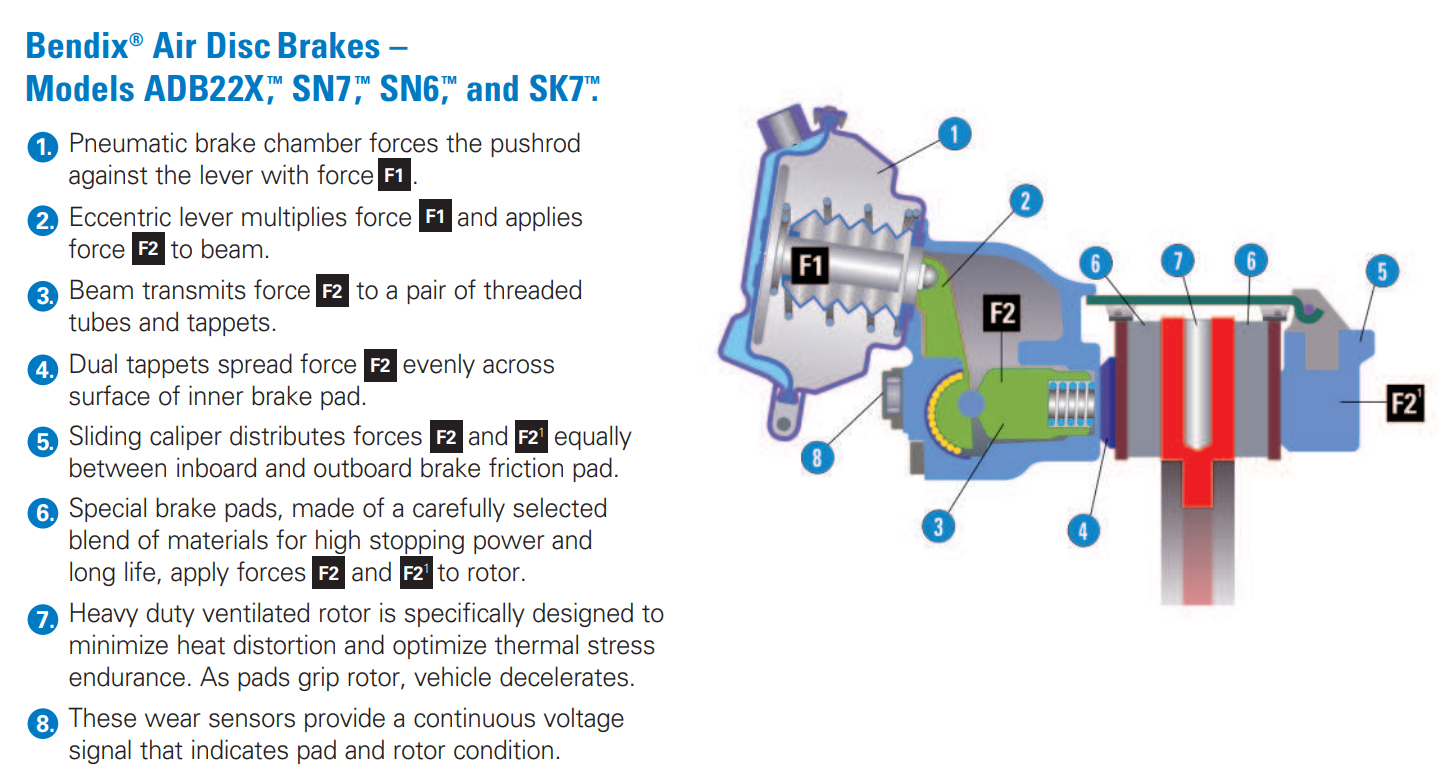Learn the Differences Between Braking Systems
Source: Wheelco
Brake drums
The drum braking system has been around for quite some time, and it’s due mostly to their simplistic design and low manufacturing cost. Not much has changed since it was patented in 1902 because the design is simple and quite simply works!
The drum braking design includes the following components: a backing plate, brake drum, shoe, wheel cylinder and a handful of springs and pins(on hydraulic), or drums ,s-cam and springs, and an air chamber( on air brakes) All are enclosed within the drum, which simplifies maintenance.
It works by using friction. The shoes or pads press outward against the drum which slows the rotation of the drum. When the drum rotation slows, so does your vehicle.
Brake Drum Design
This braking system is self-energizing. This means that the rotation of the drum can drag one or both shoes to rub hard against the drum. Therefore, it increases the stopping power. What’s so great about this is that it does this without any additional effort from the driver because it requires less input force, aka hydraulic or air pressure. At Wheelco, we carry all major brands such as Webb, Walther Engineering, Motor Wheel, Gunite, Meritor, and KIC.
However, it does make the brake more sensitive to brake fade. Due to overheating and repeat use, brake fade can occur. This results in a loss of stopping power. The solution? Replace the brake shoes. At Wheelco, we recommend using CoMan Centers brake shoes. They are affordable, dependable and don’t usually take a lot of time to replace them. Watch CoMan Centers multi-step process to create high quality, new and remanufactured brakes shoes and kits.

Drums are often applied to the rear wheels since most of the stopping force is generated by the front brakes of the vehicle. What does this mean? Less heat is generated in back. Although in some newer trucks 16” drums and wider shoes are being installed on the steer axle to comply with the new RSD rules.
Preventive Maintenance & Key Facts
- Brake stroke is key measurement during roadside brake inspections. Nearly 1 in 10 vehicles inspected during the Commercial Vehicle Safety Alliance’s annual Brake Safety Week campaign was placed out of service—due to brakes being out of adjustment. Check your slack adjusters by using a small pry bar to move it, checking the brake’s free play. Free play should be between 3/8 and 5/8 of an inch. Free play should be this small across all brakes on a system.
- Greasing and seals factors into your brake capacity. Putting in less grease than is needed may cause rust and corrosion. Seals inside the cam tube are engineered to let excess grease out of the area.
- Brake jobs are an important part of maintaining your braking system. If it’s time to do a brake job, don’t forget to check the cam bushings and shims! If the radial play is 0.030 of an inch or more, the cam bushing/camshaft needs to be replaced. Remember that cam bushings are usual a low-cost component that can make a huge difference in your braking performance. Wheelco is proud to carry spring pins and bushings from Triangle Flagg and Dayton Parts.
- Wear indicator on a caliper/pad assembly should be inspected every four months. With average life expectancy of the products, four or five checks should be made between pad chances.
- Disc inspection for cracking, a common problem, should be completed regularly.
- Service intervals for pads, rotors, and adjusters should be done on a regular basis to assess functionality. These procedures vary and can usually be found in the service literature from the manufacturer. For safety and reliability, we offer Meritor, Bendix, Haldex, and Gunite
Brake Drum Advantages
- Affordable
- Simple maintenance
- Self-energizing design
- Some weight savings from less components in design
Air Disc Brakes 101
As technology progressed, many things got faster and faster—vehicles included. Because of faster speeds, heavier loads and overall demand in performance, the air disc braking system was born. This type of braking systems consists of several parts to include: a metal rotor, brake pads and an air disc caliper.
This braking system works by use of the calipers which squeezes pads against the rotor. Air pressure fills the chamber . A metal piston inside the caliper is then forced against the back of the brake pad. This presses the pad against the spinning rotor, quickly slowing the rotation of the axle. Thus, the speed is reduced.
Compared to drum brakes, disc brakes have better stopping performance and are less prone to brake fade. Additionally, they recover more quickly than S-cam brakes.
Air Disc Brake Design
Air disc brakes are often referred to as ADBs or disc brakes. They offer an alternate design to the drum braking system. This self-adjusting braking force is proportional to the pressure placed on the brake pad. This gives the driver a better feel and decreases the chances of lockup.
The rotor is usually made of cast iron. However, in many cases, it’s created from a carbon composite. Vanes crafted into the rotors help increase cooling. Eight pistons in the brake calipers provide massive clamping forces.
Below a schematic from the Bendix Air Brake Disc system
Air Disc Brake Advantages
- Increased stopping power
- No exaggeration of friction coefficient differences
- Reduced fade
- High thermal load
- Minimal and consistent hysteresis
Reduced Stopping Distance & Regulations
In 2009, the NHSTA amended the Federal Motor Safety Standard on Air Brake Systems (FMVSS No. 121) to improve stopping distances of truck tractors. The launch of the RSD rules does not require air disc brakes. However, air disc brakes superior performance, ease of maintenance and lighter weight make air disc brakes an ideal solution for meeting the new RSD requirements.
Learn all the key facts about Reduced Stopping Distance (RSD), on Wheelco’s RSD Blog Post.
Preventive Maintenance & Key Facts
- Wear indicator on a caliper/pad assembly should be inspected every four months. With average life expectancy of the products, four or five checks should be made between pad chances.
- Disc inspection for cracking, a common problem, should be completed regularly.
- Service intervals for pads, rotors, and adjusters should be done on a regular basis to assess functionality. These procedures vary and can usually be found in the service literature from the manufacturer. For safety and reliability, we offer Meritor and Bendix.